Burleson's Story of the Alpine Ascents '97 Summit Attempt
Monday, May 26, 1997 — Base Camp
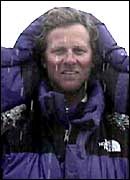 Todd Burleson |
|
|
Hear Todd Burleson describe the 1997 summit attempt |
The Great Unknown
This is Todd Burleson. It's the 27th of May. I'm back in Base Camp — I've come down early because I have to get back to America. The other four members are up still in Camp II. It's been an interesting summit year. Everest is always very interesting.
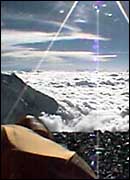 Nuptse rises out of clouds seen from the South Col [click to zoom] (photo: Burleson/ Alpine Ascents) |
God, I was hoping to have a more upbeat summit attempt for you. It really was a fantastic summit attempt. When we took off that morning, we were all very, very high. It had calmed down, we were walking on hard, neve snow. We were making incredible time. I wasn't even breathing through my mouth — I was breathing through my nose — I felt so good.
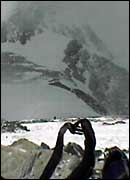 Looking back at the South Col as weather deteriorates [click to zoom] (photo: Burleson/ Alpine Ascents) |
Then the clouds moved in, and the wind started blowing, and it hit us hard, fast. I think that storm, by the end of the day, probably picked up to 60-70 mile per hour winds and just complete snow and whiteout conditions. Again, it's just the fate of Everest. We were within two hours of putting everybody on the summit and doing all the GPS work, and Everest just changed its mind.
The First Summit Attempt
On the evening of... I believe it was May 24th, we got up about 9 o'clock. It was so calm, I could not believe it. It was like just being in your own kitchen. It was so quiet. You could talk for 50' to 100' across the col. I've never seen like that in my life. Wally and I were just in awe; we were almost spooked because we'd never seen anything like it. Obviously it lead us to high hopes that we were going to make the Summit that next morning.
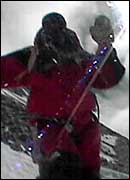 Charles Corfield on the Triangular Face. [click to zoom] (photo: Burleson/ Alpine Ascents) |
It was pretty scary. I really had to make a call. We are always under a lot of pressure from ourselves. I mean, we've been here for two months and what do we do? Do we turn around? Do we climb into this storm? What do we do? So, I lead on and after two hours I just said, "look it, we can't go any farther". We are going to climb into this horrendous storm, and people are going to get hurt. And so I turned everybody around. Which was very, very hard to do.
The Sherpa don't want to stay another day at the col. Quite often they are little bit more aggressive than we are in thinking that you can pretty much get away with it anything. So they were kind of upset. So we turned everybody around and we were back in Camp IV at about 1am, I guess.
A Second Night at the South Col
So we all went to bed a little discouraged. It was hard to call down to base camp and tell people that we called off our summit attempt. It was also little bit hard is that we knew there was a guy, [Hugo Rodriguez] a Mexican, who was a part of the OTT trip, was left up on top of the mountain. Without us there was no support for this man whatsoever. So we assumed he was dead. I kind of assumed he probably be dead anyway to have spent the night up there without oxygen.
 Todd Burleson sleeping on oxygen at the South Col (26,300') (photo: Alpine Ascents) |
The Second Summit Attempt
That night the wind blew pretty hard for the rest of the day. That night we pulled together. It was windy. We had a lot harder sleep compared to the first night. We got up; pulled our oxygen together; took off. It was pretty intense. It had calmed down; it was clear sky; we felt good about the summit attempt. Wally was pretty tired; I wasn't sure how he was going to pull out. (He ended up doing extremely well.) We took off climbing.
Basically the way it worked is Wally was oriented towards GPS. We had nine Sherpa climbing with us that day — most of them carrying oxygen and two or three carrying GPS. And five members, Eric, Greg, myself, Wally and Charles.
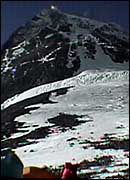 The Triangular Face of Everest leading to the Balcony (27,500'). [click to zoom] (photo: Burleson/ Alpine Ascents) |
We switched an oxygen bottle there and started heading up towards the South Summit. Things got a lot more difficult. Soon as we reached the Balcony, the winds started blowing a little bit . It wasn't bad, but it was enough to be a little spooky because it's pitch black; it's basically white out; there's some snow blowing; we probably have a 10-15 miles per hour wind. We're standing out on this ridge in the middle of nowhere.
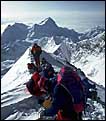 Climbers on the Balcony in '94. [click to zoom] (photo: Burleson/ Alpine Ascents) |
We were making very, very good time. We got to the base of the South Summit. Which is still a long ways from the top of the South summit. And started moving up the fixed lines, which were very poor and old and should be replaced. We thought they probably would have been the day before by the other teams that had climbed, but they had not. It was kind of hard going, slow. You wanted to be very, very careful about how hard you pulled on these lines because they could break. They didn't.
The Weather Turns Serious
We moved up for another couple of hours. And the terrain got steeper. Just about a half hour below the South Summit -- again, it was still dark about 5am — the winds started to blow pretty hard, and it started to snow pretty hard. I don't want to say complete whiteout conditions because in complete whiteout conditions you can't see a few feet in front of you. But what shocked me was that I stopped for a minute to look around, and I realized that the last time I stood at this spot, I could look 12,00 feet down the Kangshung Face; probably a 100 miles towards the plains of India, and on the other side of me, the left side I could look into Tibet and look down 8,000 feet and look out across the Tibetan plateau. It was just a whole different world. I didn't know whether I was in the summit of Mt. Everest or on the summit of Mt. Baker. We were just completely in whiteout, wind conditions blowing snow.
So we kept moving up. By this time, Wally was up with the Sherpa with the GPS. So they were probably about twenty minutes to a half hour ahead of us. Just about the time we reached the top of South Summit (28,700'), they were making the traverse across to the Hilary Step which is really the spooky part of the climb.
 Greg Wilson |
 Eric Simonson |
I got a couple of Sherpa around me, and I knew within 10 or 15 minutes we were going to have to go across the traverse which is a very technical traverse to the Hilary Step.
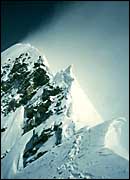 The traverse from the South Summit to the Hillary Step in '94 [click to zoom] (photo: Burleson/ Alpine Ascents) |
Freddy had given us a weather report the day before for 35 mile per hour winds, which I knew I could live with. There was no indication of a snow storm coming in, so I figured, boy, I better throw that weather forecast out — this could be a 50 to 80 to 100 mile per hour winds in the next two to three hours So what we did was — we were warm — so I said, 'let's hang out for 15 or 20 minutes and just see what happens. If conditions get worse, we'll head down. If conditions improve or stabilize, we'll go a little farther.'
We stayed for a while, and conditions did not improve, and they started to deteriorate. It was just better judgment that we do not make the traverse. Because if we did, and the winds picked up, we probably would not be able to make it back.
The Decision to Turn Around
I said, 'let's go ahead now and descend slowly and if the weather improves, we'll turn around and come back up.' As we started to descend, we saw how difficult it was to descend. Our glasses were fogging up. Charles was having quite a bit of difficulty trying to work with the lines. It was tough. It became rather obvious that we could not continue to descend if conditions worsened. So what we did, we just descended, we decided not to come back up.
 Charles Corfield |
If you take someone across that traverse, and the wind picks up, it could be extremely devastating: you'll just be trapped on the summit, and not be able to get down the Hillary Step. Charles sensed that limitation, and I think he also was very conscious of that risk, and realized that there is no right or wrong; we're only playing percentages. So, he put the percentages in his favor. He knew it was probably a good idea to go down. You know, I wanted to summit as bad as Charles. Everest is terrible that way. But we both made that decision.
Wally Berg and Four Sherpas Summit
 Wally Berg |
He sounded like he was doing well, and they started to pull out this GPS equipment, and I guess the wind started blowing pretty hard, and it became impossible for Wally to do much in the way of GPS. He told me one quick story which I hope he will tell you tomorrow. He took out the antennae, and as soon as he took it out, it blew away and started to go down the Southwest Face, got lost around a rock. He was so worried about losing this thing, that he climbed all the way down to it and picked it up and went back to the summit with it. But there was just no way to get the receivers working and the equipment working in the storm.
It was very sad because we had such an incredible, fast climbing time — I have never climbed on Everest so quickly. That we were at the South Summit around 5 or 5:30am, Wally was on the summit at 6:15am, I believe. That if the last hour or two would have just been good weather, we would have all summitted and been able to have done all the research, but it's just one of those things of Everest — kind of the fate of Everest. It picks and chooses who gets to do what on which day and when.
Losing Tenzing Norbu Sherpa
Eric and Greg, were quite a bit long gone, and we moved quite slowly down — Charles and I did, but were in control and moving down in the storm. We heard that Wally was on his way back. At that time, Lhakpa, my sirdar [lead climbng Sherpa], Nima Tashi, and Tenzing Norbu decided to go across and summit. There really wasn't a need for it, except they're just like us, they really like summiting Everest, and they traversed across and reached the summit and passed Wally somewhere along that line with the other four sherpa coming back. As we descended, things were pretty straight forward, the Sherpa caught up to us, and Wally caught up to us, and finally Lhakpa and Nima Tashi, caught up to us almost at Camp IV.
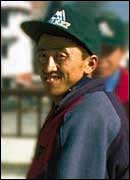 Tenzing Norbu Sherpa |
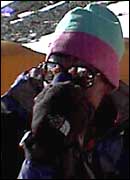 Sirdar Lhakpa Rita Sherpa breathes oxygen at the South Col |
The Sherpa are so good at what they do, that they just don't keep things as tight as they should. It's just because that's the way they climb mountains. They are strong guys; they are very aggressive. Lhakpa, Nima Tahi, and Tenzing had no reason to go across except for the pure joy of wanting to summit Mount Everest. And you know, he just disappeared. And that's what happens. I wish I could tell you more.
He was a great man. Tenzing was a Monk so, he wasn't married. He dedicated his life to Buddhism. (As a matter of fact, he oversaw our Puja at the beginning of the expedition.) And he also climbed. Just a terrific man.
That's The Way It Works
That's an amazing thing about Everest. You think about it, it's so full of irony and contradictions. I mean we just had 20 or 30 days of horrible weather almost in a row. And then we started to get a reasonable forecast and 41 people decide that they are all going to go on the same day. That's so many people. Those people hit the perfect day. And I think that's fantastic. What a great fate that out of thirty days, you pick one great day, and 41 people go for it and all of them come back alive even though one comes back a day later. It's just the luck of the draw of Everest. I mean you look at what happened in 1996, where the luck of the draw was just the opposite, and a lot of people lost their lives when they went for it all on the same day. So that's part of it.
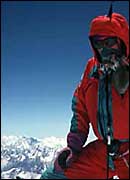 Todd Burleson on the summit of Everest in '94. [click to zoom] (photo: Burleson/ Alpine Ascents) |
I think it has been a powerful experience this year for all of us. I know for a lot of people, they won't understand why we would possibly take such risks, but it is a very, very powerful experience. It just seems to be a part of the life here that we live, and that's the way it works. It's very hard to explain.
— Todd Burleson, Alpine Ascents 1997 Expedition Leader